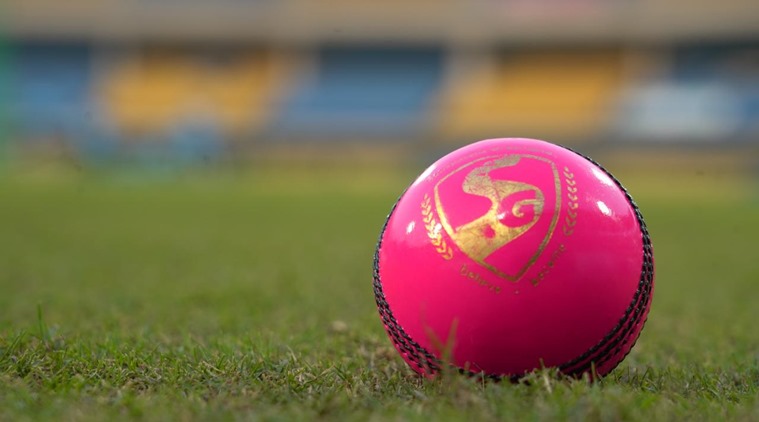Opinion The day-night Test could be overwhelmed by another format — pink-ball cricket
Cricket clearly doesn’t have space for another format — it could clutter and trivialise the game, as what has happened to cue sports.
 The day-night Test could be overwhelmed by another format — pink-ball cricket
The day-night Test could be overwhelmed by another format — pink-ball cricket  A bright pink balloon will wander over the Eden Gardens in Kolkata for the entire duration of the Test.
A bright pink balloon will wander over the Eden Gardens in Kolkata for the entire duration of the Test.
If the pink ball to be used for the first time in a Test in India could think, it would have blushed at the attention it has been receiving over the last fortnight. Seldom has the colour of a cricket ball sparked so much curiosity. A bright pink balloon will wander over the Eden Gardens in Kolkata for the entire duration of the Test, the iconic Shahid Minar, will be lit up in pink, a ferry lit with blinking pink lights will ply from Howrah Bridge to Vidyasagar Setu in the evenings, the officials will wear pink blazers, and a bunch of art students have been painting pink-ball themed murals on the walls of the stadium.
Much of this garnishing appears soul-less — like the ornate setting in a Karan Johar movie than the minimalistic backdrop of a Satyajit Ray classic. In some ways, this metaphor from cinema is apt for cricket. Arthouse movies, like Test cricket, have niche audiences, are commercially unviable and are supposedly dying. The more mainstream limited-over formats are raking in the audience, sponsors and money at a time when popularity and success is couched in an economic logic that reduces appreciation to numbers. Besides, there’s also the morbid thought about Test cricket’s impending death. The vacant seats that greet five-day cricket outside the big-three countries — India, Australia and England — only aggravate the phobia. Test cricket, no doubt, is a hard-sell and needs innovation to survive.
READ | Around Eden Gardens: A splash of bonhomie, nostalgia and lunch at 3 pm
In this context, day-night cricket, some feel, is the magic bullet that will drive hordes into the stadiums. Those who have to work for a living, and schoolchildren, will now be able to switch on their TV sets and see their national team live, outside weekends. They can wander into the stadium. Prime-time space on television is another incentive. It could blur class-borders of the cricket-watching public — as Test cricket has hitherto been content with an affluent middle-class audience largely made up of people who can take time off work or are retired. The pink-ball, thus, could paint a rosy picture, both literally and metaphorically. There have been few idyllic sights in world cricket than the wide-angle shot of Adelaide Oval at twilight during the inaugural day-and-night Test two years ago.
Day-and-night cricket deserves to be encouraged. However, there is a chance that the game itself could be overwhelmed by another format — pink-ball cricket. By shifting the scheduled hours of play and the colour and texture of ball, it seems a new game has been discovered — a similar, yet dissimilar game. For the change is more than cosmetic, it’s like listening to acoustic and electric guitars — there is nothing subtle in the differences between red-ball Test cricket and pink-ball Test cricket. Everything from the pitch and pre-match talks to strategies and permutations could be starkly different. As the pink-ball tends to scruff up prematurely, the curator ought to leave more grass, which the seamers relish. Frequent change of balls and a thicker grass-covering would compromise reverse swing and, thus, leave one of India’s strengths in the Subcontinent out of the equation. Limited exposure to sunshine means the pitch will not crack up as rapidly, as it does in the Subcontinent, neutralising another of India’s strengths. Even in the Subcontinent, teams would be encouraged to pack themselves with seamers and wrist-spinners.
The thrills and challenges, too, would be different. For instance, rather than the first hour of a day in the conventional format, it would be the twilight hour the batsman would dread the most. Consequently, the quality of a player would be judged on how he negotiates that trickiest phase. It’s during twilight that the pink ball begins showing its true nature when the unusual light effect of the floodlights and twilight begin to play tricks with a batsman’s vision. The match might not even last till the fifth day — half of the day-and-night Tests have ended in four or fewer days. This takes away the visceral joy of the ball detonating off cracks in the pitch or nimble-footed batsmen negating such tricks with dexterous hands and ice-cool temperament. The new format even requires adjusting the body-clock for both the players and the audience.
The discrepancies are so blatant that in due course, rather than popularising Test cricket, it could morph pink ball cricket into a different form of the game altogether. And cricket clearly doesn’t have space for another format — it could clutter and trivialise the game, as what has happened to cue sports. Eventually, the novelty of the format could wears off, fatigue will set in and Test cricket will be riddled with the same old existential woes. For, many of the problems of the traditional format faces — both real and imagined — can’t be changed by moving the hours or changing the colour of the ball.
Cricket needs its arthouse audience as much as it requires its mainstream formats. To blur the lines would be counterproductive.
This article first appeared in the print edition on November 22, 2019 under the title ‘When the ball turns pink’. Write to the author at sandip.gopal@expressindia.com.





